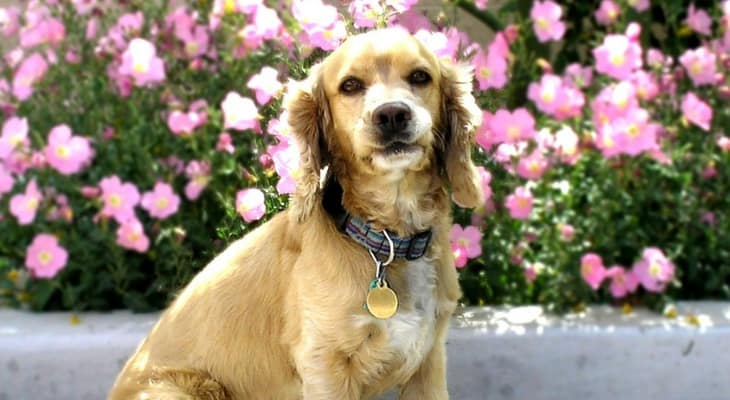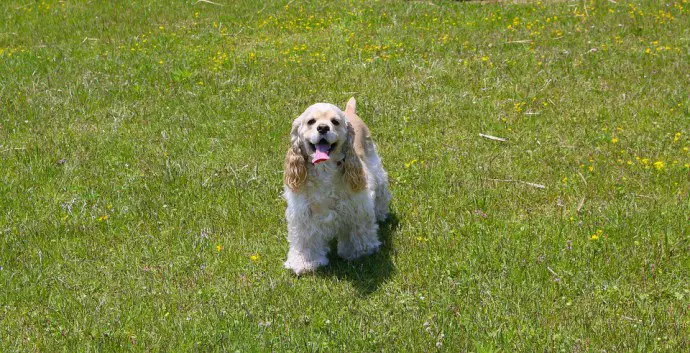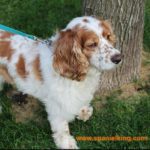English Cocker Spaniels are happy go-lucky, enthusiastic dogs known for both their hunting skills and family friendly temperaments.
These dogs love being active and will fit right in with any outdoor loving, human companion.
Table of Contents
History of The English Cocker Spaniel
This affectionate dog was once considered to be of the same breed as the American Cocker Spaniel.
It wasn’t until the 1930s that the two were recognized as separate varieties, at which time interbreeding the two was greatly discouraged. Not long after, in 1946, the English Cocker Spaniel was given an official spot in the American Kennel Club as a distinct breed of its own.
The English Cocker Spaniel is a sturdy, medium sized dog that enjoys a great deal of mental stimulation and engaging exercise.
These dogs thrive when they’re around family and other humans, and don’t particularly like alone time.
Because of their size and loving and respectful nature, though, these dogs make great traveling companions and will accompany their family anywhere.
English Cocker Spaniels, like their American counterpart, were named for their aptitude in hunting woodcock, a type of woodland bird.
Their hunting jobs include tearing through brush, flushing out prey, and retrieving game for their hunting companions. These dogs excel in both wet and dry land conditions and work well in tough terrain, staying protected from the elements with their thick coat.

Besides hunting, English Cockers are also expert trackers and enjoy both agility and obedience tasks. They’ll follow their respected companions to the ends of the earth, enjoying any activity along the way, and will happily come home to a long nap afterwards.
This lively and outgoing dog easily adapts to its surroundings, tends to get along quite well with friends, family, and other pets, and truly enjoys life.
Whether they are show dogs, hunters, or family pets, the English Cocker Spaniel is a joy to have around.
Physical Traits of The English Cocker Spaniel
The English Cocker Spaniel is part of the AKC’s Sporting Group.
This breed generally stands between 14 to 17 inches tall and weighs between 26 to 34 pounds.
They have a solid, athletic body that aids in tearing through thick brush while out in the field.
Their coat is medium length, feathered, silky to the touch, and either flat or wavy. In spite of the distinct coat of the English Cocker, their actions and movements in the field are never inhibited.
English Cockers are found in a variety of colors with various markings. In fact, the American Kennel Club Standard recognizes this breed in 18 different colors with 3 types of markings. One standout difference from their cousin is that the English Cocker does not sport the highly popular and prevalent buff color that is seen so often on American Cockers.
English Cockers are bred for both show and hunting purposes. Dogs bred for the ring tend to have a more defined coat and somewhat lower energy levels than those bred for field work.
Breed Standard of The English Cocker Spaniel
While the above qualities are prominent among English Cockers, their breed standard is much more specific. Some AKC Standards include the following:
- 16-17 inches tall at the withers for males and 15-16 inches tall for females
- A weight of 28-34 pounds for males and 26-32 pounds for females
- A softly contoured head with no sharp angles
- Medium sized, full, oval eyes that are wide set with tight lids
- Low set ears that extend to the nose
- A slightly flat skull from both side and front view
- A cushioned muzzle that is equal to the length of the skull
- A scissors bite and square jaw
- A docked tail that is carried horizontally
- Natural trimming of the coat
- Straight line movement in the gait with no crabbing or rolling
Coloring Standard of The English Cocker Spaniel
● Parti-colored English Cockers are clearly marked, ticked, or roaned. A white color can be combined with black, liver, or various shades of red. While markings are not necessary, ones that are present should be mostly evenly distributed.
● Solid colored Cockers are either black, liver, or different shades of red. Some white on the feet or throat of a solid colored dog are acceptable, but the less, the better.
● Tan markings are allowed on black, liver, or parti-colored dogs of black and liver colors. However, black and tan or liver and tan English Cockers are recognized as solid colored dogs.
Colors that fall under the AKC’s standard for English Cocker Spaniels are:
- Black, black and tan, black and white, black/white and tan
- Blue roan, blue roan and tan
- Golden
- Lemon roan
- Liver, liver and tan, liver and white, liver roan, liver roan and tan, liver/white and tan
- Orange and white, orange roan
- Red, red roan
Standard markings:
- Tan markings
- Ticked
- White markings
Temperament of The English Cocker Spaniel
English Cocker Spaniels are full of love and life. Their natural urge to hunt gives them a higher than normal energy level, and they love draining those stores with an abundance of play and activity.
These dogs also enjoy a life filled with friends and family. Their affectionate nature and sturdy size makes them great companions for children. They even get along quite well with cats and other animals when they’re raised together and properly socialized.
English Cockers might be found sniffing out different curiosities around the home during free time. This breed thoroughly enjoys learning new things. They’re intelligent and inquisitive dogs who love tracking, agility games, and obedience challenges.
While training isn’t particularly difficult, English Cockers are notably sensitive dogs. They don’t do well with harsh training or surroundings. Using any method besides positive reinforcement can push this dog away from its trainer and cause shyness or other timid behavior. When treated with love and kindness, though, this dog is loyal and obedient.

When left alone, the English Cocker can act out with bad behavior. These dogs thrive on companionship and yearn for company after too much time apart. These feelings of loneliness, boredom, and frustration can lead to barking and destruction. With plenty of mental stimulation and time with their human companions, though, English Cockers remain happy and carefree.
Because of their natural tendency as hunters, English Cocker Spaniels will always be aware of birds wherever they go. Outside walks should be done with the dog on a lead for their own safety.
Physical Abilities of The English Cocker Spaniel
English Cocker Spaniels are natural born hunters. They excel at tearing through thick brush at a steady pace (even on uphill terrain), flushing out prey, and retrieving game.
They’re also excellent trackers, with noses built for sniffing out prey, even over long distances.
These dogs love playing or retrieving in water. English Cockers fortunate enough to live near lakes, ponds, or swimming pools will lead content and fulfilled lives.
English Cocker Spaniel Health and Care
English Cockers have a general lifespan of 12 to 15 years and are typically healthy dogs.
However, there are specific health concerns for families of this breed to be aware of.
Some health concerns for English Cocker Spaniels can include:
- Progressive Retinal Atrophy – PRA is retinal degeneration with a usual onset between 1 and 8 years of age. The disease can progress over time, leading from night blindness to possible daytime blindness as well.
- Cataracts – Cataracts occur in both humans and dogs. Technically, they’re lens opacities that can eventually require surgery. Often times, though, dogs can still see without needing to surgically remove the cataract.
- Glaucoma – Seen in both humans and dogs, glaucoma causes pressure in the eye that can lead to blindness within one year.
- Hip dysplasia – Hip dysplasia is a degenerative joint disease that can cause pain and an inability for the hip to properly function.
- Renal Failure – Kidney failure (possibly inherited) can occur at a young age.
- Congenital Sensorineural Deafness – Parti-colored dogs can suffer from degenerative hearing and possible deafness during their first month of life.
- Dilated Cardiomyopathy – This disease generally affects solid colored dogs, causing a distended heart. Symptoms include a quick heart beat, weight loss, distension in the abdomen, and persistent coughing. Medications can usually treat the disease, and long term hospitalization is not normally necessary.
- Ear Infections – Long, floppy ears trap moisture inside the ear canal and can lead to infections. Regular ear checks and cleanings can act as preventative care.
Buying an English Cocker Spaniel

Finding a reputable English Cocker Spaniel breeder is of huge importance.
Breeders should also be able to provide health information of the parents that any puppy is coming from. Bad practices can lead to severe health problems and should be avoided at all cost.
Of course, like any other dog, English Cockers will appreciate regular visits to the vet. Preventative care can be suggested during these visits, like weekly ear cleanings with a vet recommended solution.
Take care when feeding this breed; English Cockers typically like to eat. If left up to choice, this breed will likely overeat, which can lead to obesity and other health problems. The recommended amount of food for the average size English Cocker is 1 to 2 cups of quality, dog food per day. Of course, consulting with a vet for each individual dog is important because dietary needs can range from one dog to the next.
Training your English Cocker Spaniel
English Cocker Spaniels are gentle and sensitive dogs. They’re deeply affected by the treatment they receive, which should always be kind, reassuring, and patient. Using positive reinforcement and a calm, consistent, and steady voice when training this breed will build trust, respect, and loyalty.
Starting training from day one with an English Cocker is the best way to teach good behavior. Just as their bodies are quickly developing, their minds are too. These dogs are eager to learn and will be less likely to adopt any negative behavioral traits if raised this way from the start.
English Cockers that are socialized well as puppies tend to grow up in happy company with other people and pets. Waiting to expose puppies to other animals, children, and friends until later in life (even at 6 months old) can lead to stubbornness.
Puppy kindergartens are wonderful places to socialize a young English Cocker if all vaccinations are up to date. If not, time spent with outside friends and family can help push this breed along with their socialization skills.
Training an English Cocker Spaniel can be fun and engaging for both dog and human, and making sure that your dog is properly cared for can speed up the process. Regular half hour walks, playtime in the back yard, and short runs as the dog develops will all keep it receptive to learning and a joy to train.

English Cocker Spaniel Vs. American Cocker Spaniel
At one point in history, the English and American Cocker Spaniels were both a part of the same breed of gun-dogs. While the English Cocker Spaniel was recognized as a different variety of Cocker, it still didn’t identify with its own separate breed.
In 1935, the English Cocker Spaniel Club of America was formed in order to promote this dog in hopes of it becoming its own breed. Just over a decade later, in 1946, their cause was finally recognized, and the English Cocker Spaniel was given a separate breed categorization of its own by the American Kennel Club.
At first, the two dogs were only identified by their size, with the American Cocker Spaniel coming in slightly smaller than the English Cocker in both weight and height. However, their traits vary far beyond that.
A notable physical difference between the two breeds of Cocker Spaniel is the shape and size of each dog’s skull. American Cockers have a round skull with a wide and deep set muzzle that’s much shorter than its English cousin’s. The eyebrows of American Cockers also show a significant difference between the breeds, theirs being much more defined than those of the English Cocker.
Beyond physical characteristics, English Cocker Spaniel’s personalities also differ from their American counterpart’s. The English Cocker is known to have much more of a “prey drive” and requires slightly more exercise because of it. The hunting instinct in American Cockers has seen a noticeable decline comparatively.
The two breeds of Cocker Spaniel definitely have their own unique qualities and characteristics. However, they also both maintain the same charm, joy, and happiness that Cockers are known for. Both breeds make excellent companions and family pets.
Conclusion
The English Cocker Spaniel is well known for both its family friendly nature and aptitude for hunting. This well adapting breed loves being outdoors, but also enjoys lounging around with the family when the time calls for it.
Raising English Cockers with love, respect, and consistency in training will result in a lifelong, loyal bond between dog and human. As a well-rounded partner, this breed will add an extra level of happiness to any family it joins.


